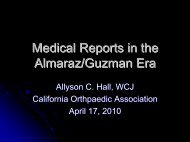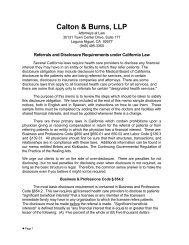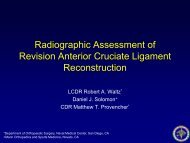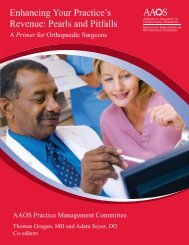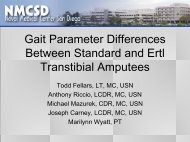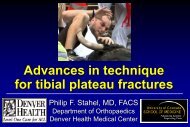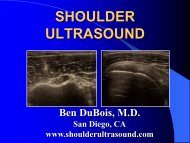AMA Guides 5th Edition - California Orthopaedic Association
AMA Guides 5th Edition - California Orthopaedic Association
AMA Guides 5th Edition - California Orthopaedic Association
Create successful ePaper yourself
Turn your PDF publications into a flip-book with our unique Google optimized e-Paper software.
<strong>AMA</strong> <strong>Guides</strong> 5 th <strong>Edition</strong>Almaraz-Guzman II: The Most Accurate ImpairmentSteven D. Feinberg, M.D.Board Certified, Physical Medicine & RehabilitationBoard Certified, Pain MedicineAdjunct Clinical ProfessorStanford University School of MedicineFeinberg Medical GroupFunctional Restoration ProgramsPalo Alto, <strong>California</strong>stevenfeinberg@hotmail.comwww.FeinbergMedicalGroup.com
WCAB Conclusions• A permanent disability rating established bythe Schedule is rebuttable• Burden of rebutting a scheduled PD ratingrests with the party disputing it– Rebutting WPI under the <strong>AMA</strong> <strong>Guides</strong>
WCAB Conclusions• When determining an injured employee’sWPI, it is not permissible to go outside thefour corners of the <strong>AMA</strong> <strong>Guides</strong>• However, a physician may utilize anychapter, table, or method in the <strong>AMA</strong><strong>Guides</strong> that most accurately reflects theinjured employee’s impairment
WCAB Caveats• The WCAB emphasizes that their“decision does not permit a physician toutilize any chapter, table, or method in the<strong>AMA</strong> <strong>Guides</strong> simply to achieve a desiredresult, e.g., a WPI that would result in apermanent disability rating based directlyor indirectly on any Schedule in effect priorto 2005”
WCAB Caveats• The WCAB emphasizes that “Aphysician’s opinion regarding an injuredemployee’s WPI under the <strong>Guides</strong> mustconstitute substantial evidence;therefore, the opinion must set forth thefacts and reasoning which justify it– Moreover, a physician’s WPI opinion that isnot based on the <strong>AMA</strong> <strong>Guides</strong> does notconstitute substantial evidence
First Step• The evaluating physician needs to firstprovide a WPI using the <strong>AMA</strong> <strong>Guides</strong> in astandard, literal, strict or traditionalapproach and keeping within the chapterfor the relevant body part
When Almaraz-Guzman II?• Almaraz-Guzman II states that “Once atreating physician, AME, or QME hasoffered an opinion regarding the injuredemployee’s WPI under the <strong>AMA</strong> <strong>Guides</strong>,then the injured employee or the defendantmay seek to challenge that opinion throughrebuttal evidence”• Confusion over this issue
Activities of Daily Living• The <strong>AMA</strong> <strong>Guides</strong> states that “Impairmentpercentages or ratings developed bymedical specialists are consensus-derivedestimates that reflect the severity of themedical condition and the degree to whichthe impairment decreases an individual’sability to perform common activities ofdaily living (ADL), excluding work”
Addressing Almaraz-Guzman II• In regards to actually addressing Almaraz-Guzman II, it seems very clear that it iscritical to analyze the injured workersactivities of daily living (ADLs)• If a “standard” WPI does not take intoaccount significant ADL deficits, then thiswould be a justification for applyingAlmaraz-Guzman II
ADLs & Credibility Issues• Activities of daily living are subjective– Something that the injured worker describesto the evaluating physician• While respectful of the patient’s reportregarding functional limitations in ADLs,the physician must determine if this reportis consistent with the objective medicalfindings
Objective Findings• Apply A-G II if the strict WPI does notadequately address legitimate objectivemedical factors/pathology
What Does Most AccurateImpairment Rating Mean?• The term “accurate” is not given in anycontext by the WCAB• We can assume that the term “accurateimpairment rating” refers to a relationshipbetween the industrial injury and thepermanent effects an objective medicalcondition has on the injured employee’sability to perform ADLs
Controversial Issues• The question becomes which ADLs we aretalking about?• Rebuttal is to a scheduled permanentdisability rating• Activities of Daily Living (ADL)–Home–Work
Defense will Argue <strong>AMA</strong> <strong>Guides</strong> ADLs• Self-care & personal hygiene:combing hair, bathing, dressing oneself, eating• Communication:• Physical activity:• Sensory function:• Non-specialized hand activities:discrimination• Travel:Riding, driving, flying• Sexual function:Urinating, defecating, brushing teeth,Writing, typing, seeing, hearing, speakingStanding, sitting, reclining, walking, climbing stairsHearing, seeing, tactile feeling, tasting, smellingGrasping, lifting, tactileOrgasm, ejaculation, lubrication, erection• Sleep: Restful, nocturnal sleep pattern
Applicant will argue for Work ADLs(since the goal is to provide an accurate permanent disability award)Also consider pacing (speed of activity), repetition (repetitive activities), time (prolonged activity), andpositioning (static or awkward posturing) factors
Bottom Line• It is critical that the physician’s reportprovide a WPI that is the most accuratereflection of the impairment that meets thecriteria of being substantial medicalevidence• Provide different "scenarios" that addressthe concerns of both the applicant and thedefendant - leave the final decision aboutwhat is substantial evidence to the WCAB
Functional Capacity Evaluation• Functional Capacity Evaluations (FCEs)• Functional Capacity Assessments (FCAs)• Work Capacity Assessments (WCAs)• Valuable in determining an individual’s lossof work and self care (ADLs) capacity andretained abilities• Useful in assessing work ability whiledefining areas of inability that can be treated•
Most AccurateReflection of theImpairmentRating by Analogy&Other Approaches
The <strong>AMA</strong> <strong>Guides</strong> State:• “After all potentially impairing conditions havebeen identified and the correct ratings recorded,the evaluator should select the clinically mostappropriate (i.e., most specific) method(s) andrecord the estimated impairment for each (<strong>5th</strong> ed, 526)”• “Typically, one method will adequatelycharacterize the impairment and its impact on theability to perform ADL• In some cases, however, more than one methodneeds to be used to accurately assess all featuresof the impairment (<strong>5th</strong> ed, 527)”
Rating by Analogy• A similarity between two things• When the WPI is not the most accurate,consider other impairments that create asimilar effect on ADLs
Support for Rating by Analogy• On page 11, the <strong>AMA</strong> <strong>Guides</strong> states:Given the range, evolution, and discoveryof new medical conditions, the <strong>Guides</strong>cannot provide an impairment rating for allimpairments• Also, since some medical syndromes arepoorly understood and are manifested onlyby subjective symptoms, impairmentratings are not provided for thoseconditions
Support for Rating by Analogy•The <strong>Guides</strong> nonetheless provides aframework for evaluating new or complexconditions• Most adult conditions with measurableimpairments can be evaluated under the<strong>Guides</strong>
Support for Rating by Analogy• In situations where impairment ratings arenot provided, the <strong>Guides</strong> suggests thatphysicians use clinical judgment,comparing measurable impairmentresulting from the unlisted condition tomeasurable impairment resulting fromsimilar conditions with similar impairmentof function in performing activities of dailyliving. <strong>AMA</strong> <strong>Guides</strong>, Chapter 1, page 11
Support for Rating by Analogy• The physician’s judgment, based uponexperience, training, skill, thoroughness inclinical evaluation, and ability to apply the<strong>Guides</strong> criteria as intended, will enable anappropriate and reproducible assessmentto be made of clinical impairment.• Clinical judgment, combining both the “art”and “science” of medicine, constitutes theessence of medical practice.<strong>AMA</strong> <strong>Guides</strong>, Chapter 1, page 11
Nerve Entrapment Syndrome• For carpal tunnel syndrome, the DEU isallowing a 5% upper extremity Impairmentrating (3% WPI) for someone with normalphysical findings but abnormalelectrodiagnostic testing (EMG/NCV) evenwithout surgery (if you went by the book,there would be no impairment rating in thissituation absent surgery)• How about Ulnar nerve compromise at theelbow?
Epicondylitis & Grip Loss• The <strong>Guides</strong> allows you to use grip strength ifthere is a tendon rupture (an MRI may beneeded to determine this) or surgery (16.8 StrengthEvaluation, page 507)• By analogy it makes clinical sense to be able todo an Impairment Rating using grip loss evenwithout surgery if the clinical picture is credibleand the objective findings are reliable• It is critical that the physician clearly andunequivocally state that the injured worker iscredible and the testing results are reliable
Alternate Approaches• Another approach is for the evaluatingphysician to consider alternate ways touse the <strong>AMA</strong> <strong>Guides</strong> such as recognizingthat the injured worker has a "neuralgia" orneuropathic chronic pain condition
Neuropathic Pain• In the <strong>Guides</strong>, page 343, The Central andPeripheral Nervous System, 13.8 Criteriafor Rating Impairments Related to ChronicPain it states: “Impairment due primarily tointractable pain may greatly influence anindividual’s ability to function.
Neuropathic Pain• Chronic pain in this section covers thediagnoses of causalgia, posttraumaticneuralgia, and reflex sympatheticdystrophy (my underline).”• Neuralgia or neuropathic pain may beseen in many conditions, particularly withentrapment neuropathies such as carpaltunnel syndrome and in various otherchronic pain states including with failedspine surgery
Neuropathic Pain• Pain caused by abnormal function of thenervous system due to injury or disease• Neuropathic pain is characterized bylancinating, paroxysmal, tingling, andburning sensations• These conditions are notoriously difficult totreat and can often be associated withdepression, anxiety, decreased libido,altered appetite, and sleep disturbances
Rating by Analogy• The following Tables are functionally based– Table 13-22, Criteria for Rating ImpairmentRelated to Chronic Pain in One UpperExtremity– Table 13-17, Criteria for Rating Impairment inTwo Upper Extremities– Table 13-15 Criteria for Rating ImpairmentsDue to Station and Gait Disorders
Upper Extremity Chronic Pain
Station & Gait Disorders
Direct ADL Method• Upper Extremity (Table 16-3)– UE impairment up to 60% WPI per limb– 25% loss of preinjury capacity = 15% WPI• Lower Extremity (Table 17-3)– LE impairment – 40%– 25% loss of preinjury capacity – 10% WPI
The ADL Method
Alternative Tables• There may be another Table in a differentChapter that provides a reasonable andsupportable impairment by analogy
Chapter 6 The Digestive System• Table 6-9 Criteria for Rating PermanentImpairment Due to Herniation(Anthony Ferras v. United Airlines)
Spine (Chapter 15)• Diagnosis-Related Estimates – DRE• Range of Motion Method – ROM• There is enough ambiguity between DREand ROM to do it both ways and take thehigher impairment rating (assuming thephysician believes it to be the mostaccurate)
DRE Method Problems• Can’t get past a DRE III without loss ofmotion segment integrity• Consider DRE IV or V if– there is radiculopathy even without alteration ofmotion segment integrity when there issignificant lower extremity impairment ispresent as indicated by atrophy or loss ofreflex(es), pain, and/or sensory changes withinan anatomic distribution (dermatomal), orelectromyographic findings
Spine• Consider combining using Table 15-6Rating Corticospinal Tract Impairment• DRE III is a generic rating, but specificcases of radiculopathy vary, some have anormal gait, others ( as with a total footdrop) have a very impaired gait, and someare in between
Page 396
Page 397
Spine Percentages• The <strong>AMA</strong> <strong>Guides</strong>, Chapter 15, The Spine,page 427, 15.13 Criteria for ConvertingWhole Person Impairment to RegionalSpine Impairment• Lumbar 90%, Thoracic 40%, and Cervical 80%.• 50% loss of lumbar spine function forADLs would provide a 45% WPI (50% X90% = 45%)
Spine & Lower Extremity Disability“…for full-time gaitderangements ofpersons who aredependent onassistivedevices.” <strong>AMA</strong> <strong>Guides</strong> page 529
Hip & Knee Disability• Tables 17-33, 17-34, & 17-35 are functionaland could be considered even when therehas not been a joint replacement
Headache• Typically only 3% allowed using CPChapter 18• Consider using CNS Chapter 13 as achronic and intractable headache can affectalertness, cognition and ability to performADLs
Combining for the Lower Extremities
Combining for the LEs• If using Table 17-2 Guide to theAppropriate Combination of EvaluationMethods results in a WPI that is not themost accurate reflection of the impairment,consider using (combining) all Methodsthat are appropriate
Combining• The <strong>AMA</strong> <strong>Guides</strong> does not allow combiningcertain impairments– i.e., you cannot use strength when there is arange of motion (ROM) loss or a compressionneuropathy• If this results in a WPI that is not the mostaccurate reflection of the impairment,consider combining
Combining versus Adding• Combining decreases the resultantimpairment: 30% + 30% = 51%• Consider adding (30% + 30% = 60%)rather than combining if this provides themost accurate reflection of the impairment
Combining versus Adding• The <strong>AMA</strong> <strong>Guides</strong> itself on page 10, makesa case against combining “Other optionsare to combine (add, subtract, or multiply)multiple impairments based upon theextent to which they affect an individual’sability to perform activities of daily living(my underline).”
Strength• Because strength measurements arefunctional tests influenced by subjectivefactors that are difficult to control and the<strong>Guides</strong> for the most part is based onanatomic impairment (my underline), the <strong>Guides</strong>does not assign a large role to suchmeasurements (16.8 Strength Evaluation, page 507)• It does not say no role!
Rating Strength• In a rare case, if the examiner believes theindividual’s loss of strength represents animpairing factor that has not beenconsidered adequately by other methodsin the <strong>Guides</strong>, the loss of strength may berated separately (16.8a Principles, page 508)• The physician determines what constitutesa “rare” case and when strength should beused!
Loss of Strength• Decreased strength cannot be rated in thepresence of decreased motion, painfulconditions, deformities, or absence of parts (eg,thumb amputation) that prevent effectiveapplication of maximal force in the region beingevaluated (16.8a Principles, page 508)• The physician could choose to alternatively rateby loss of strength if clinically there is applicationof maximal force
Grip Strength• Grip strength can be used when there is a“loss of strength due to a severe muscletear that healed leaving a palpable muscledefect (16.8a Principles, page 508)• By analogy, the MD could rate based onconsistent weakness due to an injury• It is critical that the physician clearly andunequivocally state that the injured workeris credible and the testing results arereliable
Grip Strength• If the following is true:– If there is evidence that the individual isexerting less than maximal effort, the gripstrength measurements are invalid forestimating impairment (16.8b Grip and Pinch Strength, page 509)• Then shouldn’t this be true?– If there is evidence that the individual isexerting maximal effort, the grip strengthmeasurements are valid for estimatingimpairment– Doesn’t the physician determine validity?



